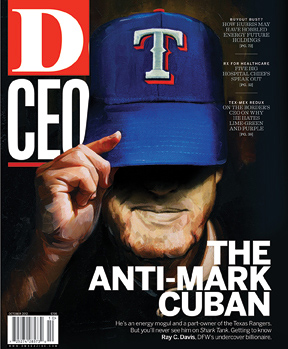Still, it’s fair to wonder how long Fossil can produce like this, gobbling up market share at home and growing abroad. In the 2000s, when sales fell at U.S. department stores and discounters, the annual growth rate at clothing and accessories stores was 2.5 percent. But Fossil grew six times faster over the same period.
Was the first-quarter slip a sign that Fossil may finally start topping out? Or was the company just catching its breath so that, three months later, it could resume its relentless march forward?
“Huge Demand”
One analyst urged executives to look ahead over the next five years and consider whether Fossil should choose between licensed watches and its lifestyle brands. The former has grown much faster, but the latter is a great way to leverage the Fossil name.
It was a kind way of asking whether management could handle it all. “We still think there’s a bunch of runway ahead for Fossil,” CEO Kosta Kartsotis said in the conference call in May. In August, he was even more bullish: “We have a lot of opportunity to get better at what we do,” Kartsotis told analysts.

Fossil wants to be there with everything, not just fashion faves like Michael Kors. “To us it’s a very compelling business model,” Kartsotis said.
In other words, Fossil is all in, with the CEO saying it’s the early innings of a large multi-year opportunity. Rather than retreat, the company plans to open 75 stores this year. It wants to add 65 to 70 concession areas in Asia, so it will have 280 in place by year-end. Fossil manages those retail counters and pays a commission to department stores.
Changes are under way, but they’re more like an eyebrow tweeze than a makeover. The company has about 30 percent fewer items in its catalog, so it can “tell fewer stories and tell them much better,” Kartsotis said. And the emphasis is on iconic styling, rather than fashion.
I wouldn’t know the difference between an icon and a fashion item, but I know that Fossil’s look always seems to work. Vintage style, mid-20th century inspiration, roots in authenticity—those are phrases that inform the designers’ thinking and seep into every corner of the company. Even its new headquarters in Richardson was recycled in modern vintage.
As Fossil becomes larger, it’s harder to move the needle on sales. In April, Fossil completed the purchase of Skagen Designs, a Danish watchmaker and jewelry company. It plans to “turbo-charge” the business by funneling it into the Fossil machine, which is one more way to counter a slowdown. In the second quarter, Skagen accounted for much of the sales gain in Europe.
In 2009, after the Great Recession, Fossil sales slipped 2 percent. The company stormed back the next two years, with gains of 31 percent and 26 percent. In 2001, during another recession, sales growth fell into single digits; then Fossil strung together three years of gains averaging more than 20 percent.
So Fossil has been knocked back before, but not down. In 1995, two University of Baltimore professors wrote a case study on Fossil, detailing how Tom Kartsotis came out of nowhere to build a fashion watch company. The report included the strategies laid out in the initial public offering, and the priorities then are the same today.
One more common thread: doubts about how long Fossil could maintain the pace. The company’s success, the professors wrote, had attracted attention, so it was sure to face tougher competition and plenty of imitators.
“Future growth was likely to be even more challenging than past accomplishments,” they concluded.
In 1995, they couldn’t have been more wrong. For a short time last spring, Wall Street didn’t know much better.





